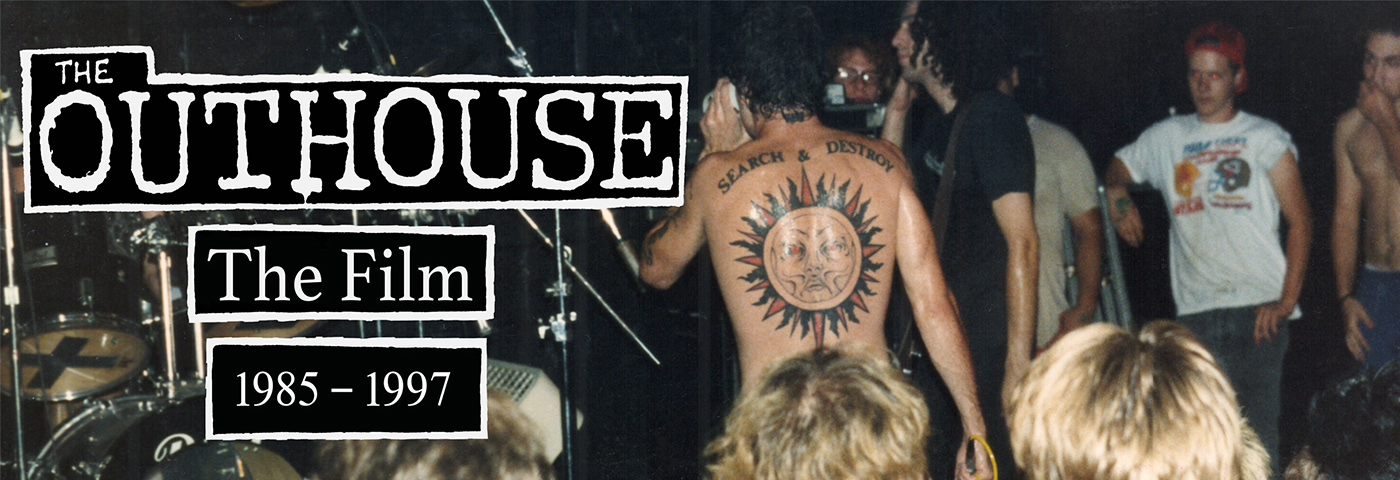



In the mid-1980s outside this college town, home of the Kansas Jayhawks, punk rock history was being made in the middle of a cornfield. Where the pavement turned to gravel, in a small, primitive cinder block building, bands like Fugazi, the Melvins, Rollins Band, Gwar, the Circle Jerks, Body Count, Social Distortion, Bad Brains, White Zombie, Descendents, Sonic Youth, Green Day, Fishbone, the Meat Puppets, Helmet and Nirvana played to all-ages crowds, a raucous scene of misfits and anarchists on the margins of youth culture. This was The Outhouse. Small, dark and sometimes dangerous, it quickly gained a reputation as a haven for the bands other venues were afraid of, and the kids who loved them.
“The Outhouse” tells the story of this legendary, lawless punk venue (1985-1997) in the voices of the musicians, the fans, the promoters, the local sheriff and the pissed-off neighbors. Independent filmmaker Brad Norman, an Outhouse regular who later booked bands there, spent five years tracking down amateur footage, grainy photos and show flyers, and interviewing regulars and musicians, including Ice T, Henry Rollins, Fugazi’s Ian MacKaye and Gwar frontman Dave Brockie. “It’s been thirty years, but when you ask people about The Outhouse, they can remember it clearly,” Norman says, ”It was amazing.” The film, which premieres in October, is an unflinching snapshot of a place and time, during alternative music’s heyday, before it went mainstream.
In 1985, the Midwest punk scene was mostly underground, with shows in abandoned buildings, houses, VFW halls. Middle America was struggling, clawing its way out of a recession, anxious about the Cold War. “The Day After” had just been filmed in Lawrence. Kansas City was obliterated on network TV. “It was a scary time,” Norman says. “We knew if there was a nuclear war, we were all gonna die.” To a lot of troubled kids, the music of the day — Madonna, Wham!, Foreigner, Tears for Fears — had nothing to do with them, or the real world. Punk music was political, angry, anti-authoritarian and brutally honest. It felt the way they felt. “I couldn’t relate to ‘My Maserati does 185,’” Norman says. “But I could relate to ‘I’m wasted’ and ‘I don’t care about you.’” The culture was welcoming to kids who felt like outcasts.
The Outhouse was born out of chance and necessity. The owner, a biker, bought the place to work on motorcycles and cars. But that never happened. At first, he rented it out for frat parties. One of the first shows was a benefit for a photographer arrested at a house concert, his camera destroyed by the cops. Venues in Lawrence had closed. The ones that remained were wary of punk bands and the crowds they drew. “Bands needed someplace to play between Denver and Chicago,” Norman says. Soon, The Outhouse became the go-to. Though bands were often shocked when they got there.
“It seemed like you drove forever,” Norman says. “I think every band thought they were gonna get robbed,” he says. “They showed up early and thought, Who even knows about this place?” The venue’s moniker was among the building’s colorful nicknames: “cinderblock shack,” “concrete bunker,” “shithole.” “It was pitch dark out there,” Norman says. And the parties and bonfires in the dirt parking lot could be wild. In the summer, it was literally surrounded on three sides by corn. In the winter, there was no heat. The first time Fugazi played, they didn’t get out of their van until show. They were too afraid. College students mixed with kids as young as 6th grade. There was no security, the stage a wooden box a foot off the cement floor. The toilets worked sporadically. (Promoters hauled in water for a cistern.) But soon, shows were drawing hundreds. “There were sometimes more people outside than inside,” Norman says. “Bad Brains drew 1,200 people. It was crazy.” William Burroughs, who lived in Lawrence, became part of the scene, coming out during the day to make art and shoot his shotguns.
Off and on for 13 years, local favorites and important bands emerging from the national scene drove fans at The Outhouse into slam-dancing frenzies. Regulars from the area became a sort of family. But shows drew audiences from far and wide. Eventually, though, the music landscape changed. “Punk ‘broke,’ Bands that would play at The Outhouse could fill up bigger venues,” While punk music’s rebellious story has been told many times in films like “Suburbia” and “American Hardcore,” Brad Norman shines a light on the 1980s and ‘90s in the Midwest. A scene that was as diverse as it was thrilling.
“At The Outhouse, you’d see kids with mohawks and kids with mullets. Straight-edged teens and skinheads,” Norman says. “And before Nirvana broke, punk rock was not a type of music. There wasn’t a punk sound. No one could put their finger on it, and say they’re playing ‘punk rock.’ Punk bands were called punk bands because the people in them were punks. The Bad Brains didn’t sound like the Dead Kennedys, and so on. They were all ‘punks.’ They were free thinkers. They were creative. They did what they wanted. Define punk? It’s like freedom. It’s like truth.”
| Price | Location/Details |
|---|---|
| $10 | General Admission |
6 p.m.